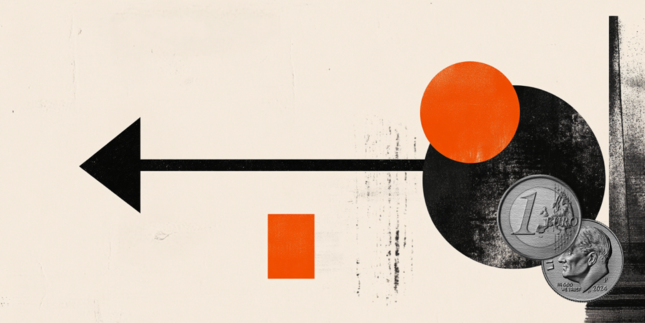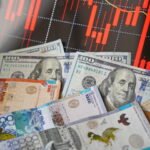EUR/USD failed to make a decisive move on Monday and closed the day virtually unchanged. The pair remains in a consolidation phase early Tuesday and continues to fluctuate near 1.1550.
Euro Price This week
The table below shows the percentage change of Euro (EUR) against listed major currencies this week. Euro was the strongest against the Japanese Yen.
| USD | EUR | GBP | JPY | CAD | AUD | NZD | CHF | |
|---|---|---|---|---|---|---|---|---|
| USD | -0.03% | 0.14% | 0.19% | -0.19% | -0.49% | -0.36% | -0.24% | |
| EUR | 0.03% | 0.16% | 0.25% | -0.19% | -0.49% | -0.36% | -0.24% | |
| GBP | -0.14% | -0.16% | 0.16% | -0.35% | -0.65% | -0.52% | -0.39% | |
| JPY | -0.19% | -0.25% | -0.16% | -0.44% | -0.73% | -0.59% | -0.52% | |
| CAD | 0.19% | 0.19% | 0.35% | 0.44% | -0.21% | -0.18% | -0.11% | |
| AUD | 0.49% | 0.49% | 0.65% | 0.73% | 0.21% | 0.13% | 0.25% | |
| NZD | 0.36% | 0.36% | 0.52% | 0.59% | 0.18% | -0.13% | 0.12% | |
| CHF | 0.24% | 0.24% | 0.39% | 0.52% | 0.11% | -0.25% | -0.12% |
The heat map shows percentage changes of major currencies against each other. The base currency is picked from the left column, while the quote currency is picked from the top row. For example, if you pick the Euro from the left column and move along the horizontal line to the US Dollar, the percentage change displayed in the box will represent EUR (base)/USD (quote).
The risk-positive market atmosphere on growing optimism about the US government shutdown coming to an end made it difficult for the US Dollar (USD) to gather strength. Nevertheless, the uncertainty surrounding the Federal Reserve’s (Fed) policy decision in December capped the pair’s upside, as investors refrained from betting on a broad USD weakness given the heightened probability of a Fed policy hold.
November ZEW Survey – Economic Sentiment Index data for Germany and the Eurozone will be featured in the European economic calendar on Tuesday. Later in the session, NFIB Business Optimism Index and the Automatic Data Processing’s (ADP) newly introduced weekly ADP Employment Change data will be watched closely by market participants.
In case there is a negative print in the ADP data, the USD could come under renewed selling pressure and allow EUR/USD to stretch higher. On the flip side, a reading at or above 20K could have the opposite impact on the currency’s action.
Meanwhile, US stock index futures trade mixed following the risk rally seen in Wall Street on Monday. The funding bill, which will pave the way for the government’s reopening and was approved by the Senate, will head to the House of Representatives for a final approval on Wednesday. Once the government is funded, investors will await the release of key data, such as the Consumer Price Index, Nonfarm Payrolls and Gross Domestic Product, that were postponed during the shutdown.
EUR/USD Technical Analysis

EUR/USD trades between the 50-period and the 100-period Simple Moving Averages (SMAs), while the Relative Strength Index (RSI) indicator moves sideways slightly above 50, reflecting the pair’s indecisiveness.
On the downside, 1.1530 (50-period SMA) aligns as the first support level before 1.1500 (static level) and 1.1450 (end-point of the downtrend). Looking north, resistance levels could be spotted at 1.1570-1.1580 (Fibonacci 23.6% retracement of the latest downtrend, 100-period SMA), 1.1630 (200-period SMA, Fibonacci 38.2% retracement) and 1.1680 (Fibonacci 50% retracement).
Euro FAQs
The Euro is the currency for the 20 European Union countries that belong to the Eurozone. It is the second most heavily traded currency in the world behind the US Dollar. In 2022, it accounted for 31% of all foreign exchange transactions, with an average daily turnover of over $2.2 trillion a day.
EUR/USD is the most heavily traded currency pair in the world, accounting for an estimated 30% off all transactions, followed by EUR/JPY (4%), EUR/GBP (3%) and EUR/AUD (2%).
The European Central Bank (ECB) in Frankfurt, Germany, is the reserve bank for the Eurozone. The ECB sets interest rates and manages monetary policy.
The ECB’s primary mandate is to maintain price stability, which means either controlling inflation or stimulating growth. Its primary tool is the raising or lowering of interest rates. Relatively high interest rates – or the expectation of higher rates – will usually benefit the Euro and vice versa.
The ECB Governing Council makes monetary policy decisions at meetings held eight times a year. Decisions are made by heads of the Eurozone national banks and six permanent members, including the President of the ECB, Christine Lagarde.
Eurozone inflation data, measured by the Harmonized Index of Consumer Prices (HICP), is an important econometric for the Euro. If inflation rises more than expected, especially if above the ECB’s 2% target, it obliges the ECB to raise interest rates to bring it back under control.
Relatively high interest rates compared to its counterparts will usually benefit the Euro, as it makes the region more attractive as a place for global investors to park their money.
Data releases gauge the health of the economy and can impact on the Euro. Indicators such as GDP, Manufacturing and Services PMIs, employment, and consumer sentiment surveys can all influence the direction of the single currency.
A strong economy is good for the Euro. Not only does it attract more foreign investment but it may encourage the ECB to put up interest rates, which will directly strengthen the Euro. Otherwise, if economic data is weak, the Euro is likely to fall.
Economic data for the four largest economies in the euro area (Germany, France, Italy and Spain) are especially significant, as they account for 75% of the Eurozone’s economy.
Another significant data release for the Euro is the Trade Balance. This indicator measures the difference between what a country earns from its exports and what it spends on imports over a given period.
If a country produces highly sought after exports then its currency will gain in value purely from the extra demand created from foreign buyers seeking to purchase these goods. Therefore, a positive net Trade Balance strengthens a currency and vice versa for a negative balance.





















